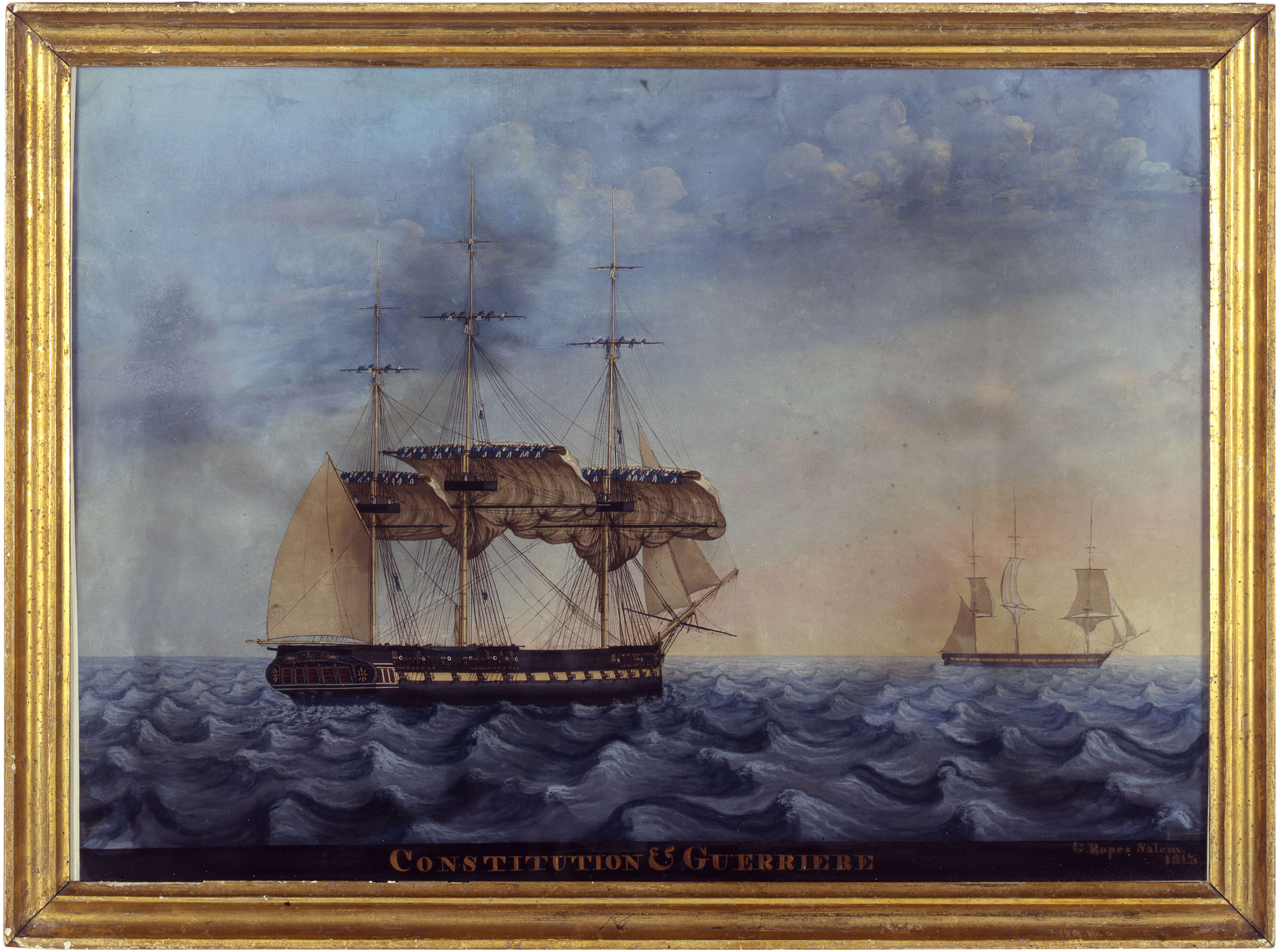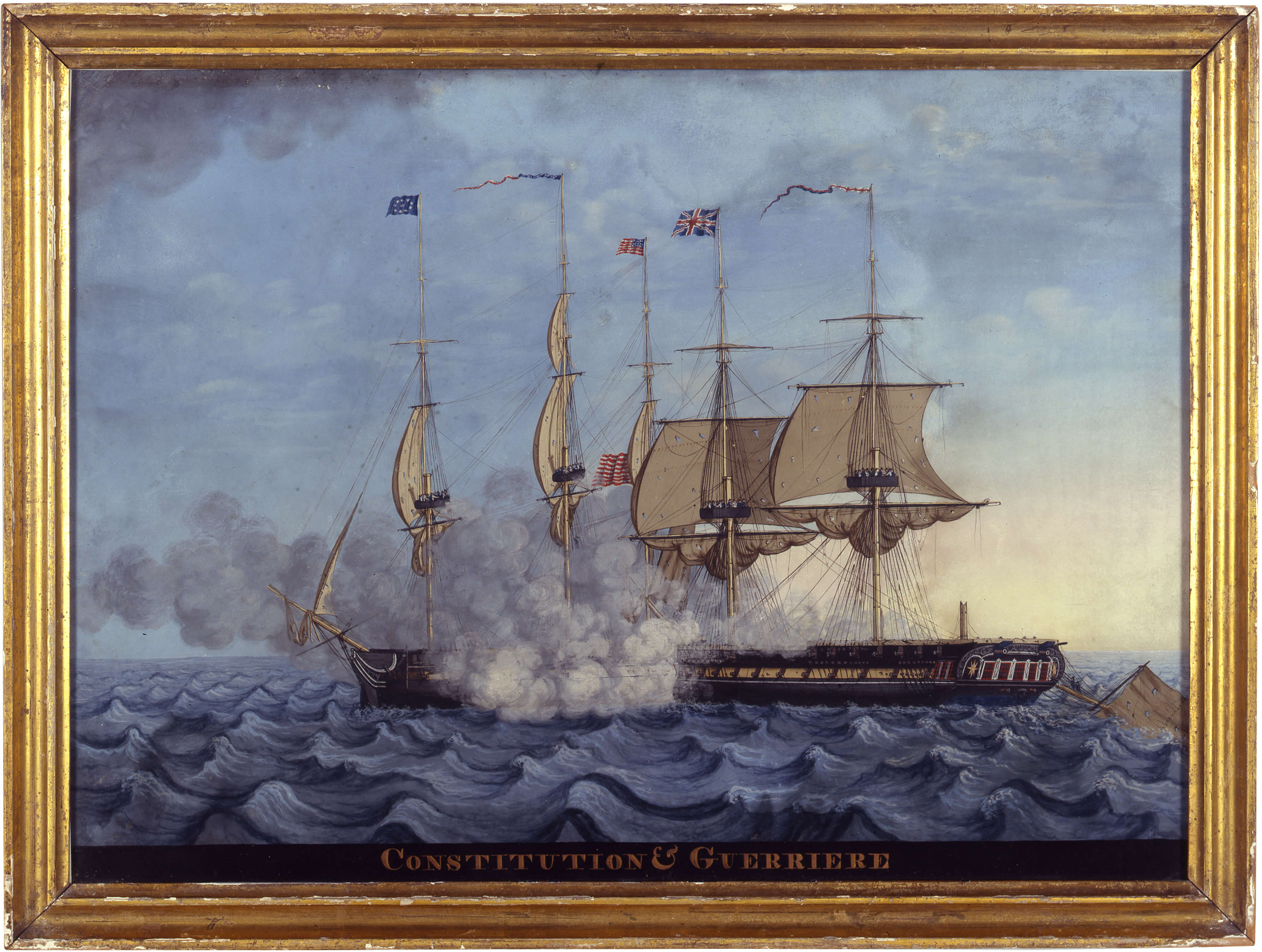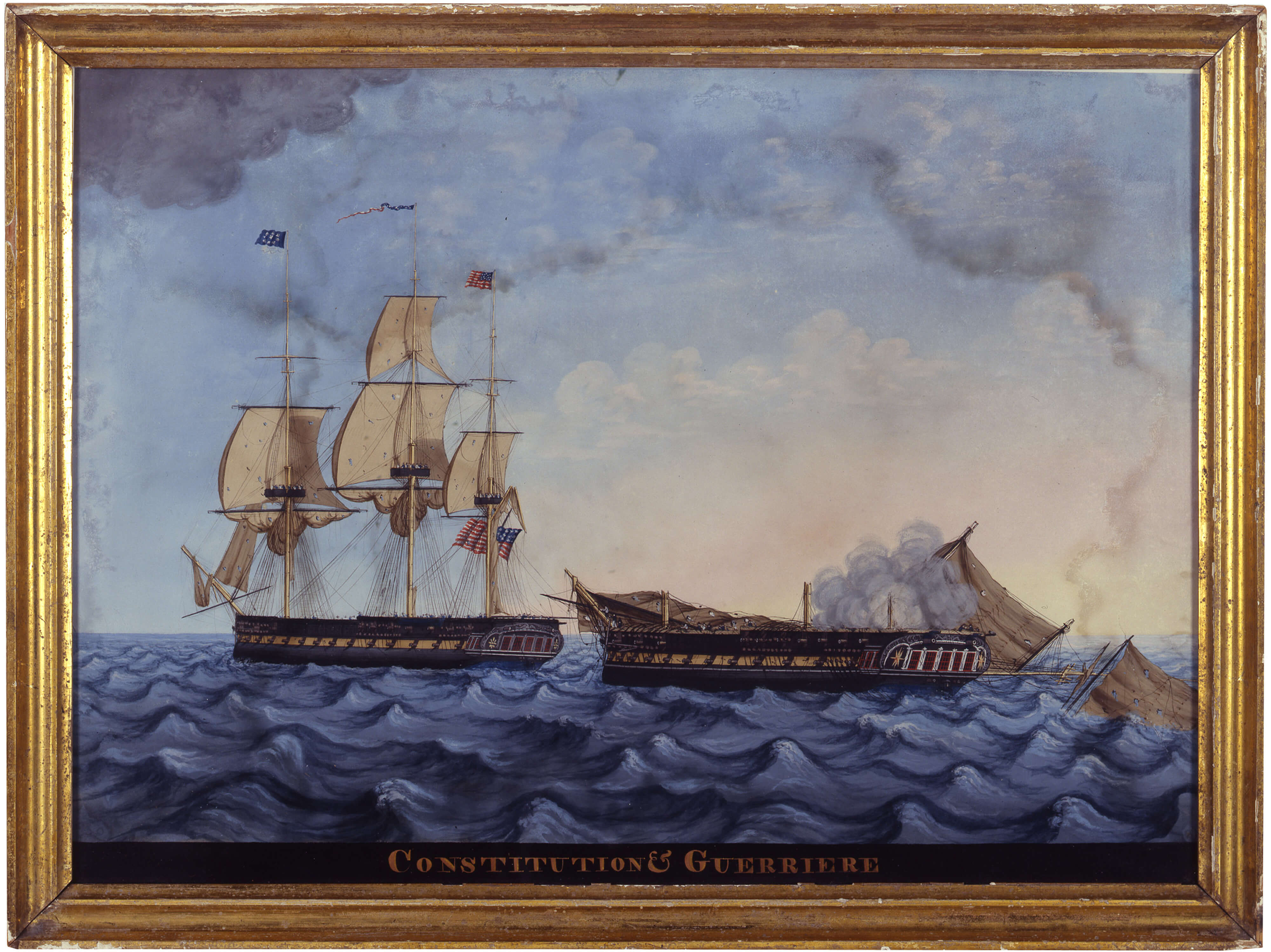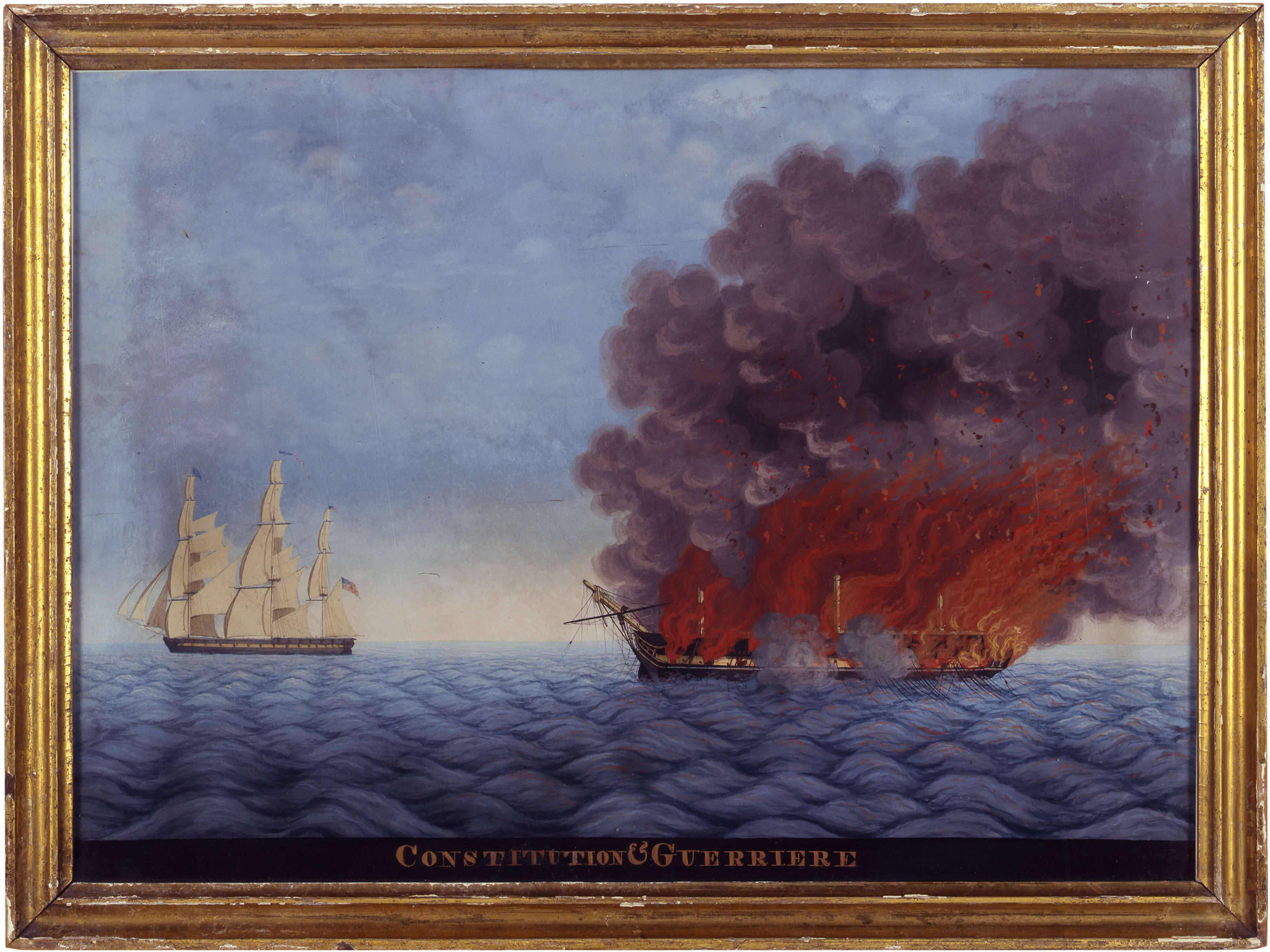On August 19, 1812, USS Constitution met and defeated the British frigate HMS Guerriere. It was a decisive victory, as sensational then as it is interesting today. It was not the first American naval victory of the war (that honor went to USS Essex’s crew, who captured HMS Alert on August 13), but it won ever-lasting laurels for the victors and established Constitution (newly christened “Old Ironsides”) as a household name.
Constitution’s log1 gives the best description of what happened next:
19 Aug 1812 [Wednesday]
“At 2 PM discovered a Sail to the Southward made all sail in chace, at 3 PM perceived the chace to be a Ship with her Starboard Tacks on board, close hauled by the wind, at 1/2 past closing fast with the chace who appeared to be a Frigate, at 1/4 before 5 PM the Frigate lay her Main Topsail to the Mast, Took in our Top Gallant Sails, Staysails, flying Jib, hauled the Courses up, took 2d Reef in the Topsails, and sent down the Royal Yards, and got all snug, and ready for action and beat to Quarters, at which our Crew gave three Cheers…”

“…at 5 PM bore more up bringing the Chace to bear rather off the Starboard Bow, she at that time discovering herself to be an Enemy by hoisting three English Ensigns, at 5 min after 5 PM, she discharged her Starboard broadside at us without effect, her shot falling Short she immediately wore round, and discharged her Larboard Broadside two Shot of which hulled us and the remainder flying over, and through our rigging, we then hoisted our Ensign and a Jack at Fore and Main top Gallant Mast heads, the enemy still manouvring [sic] to rake us firing alternately his Broadsides, we returning his fire with as many of our Bow Guns from the Main Gun deck as we could bring to bear on her, at 3/4 past 5 PM the Enemy finding his attempt to rake us fruitless, bore up with the wind rather on his Larboard Quarter, we then sett our Main Top Gallant Sail and Steered down on his Beam in order to bring him to close action, at 5 minutes after 6 PM hauled down the Jib and lay the Main Top Sail Shivering and opened on him a heavy fire from all our Guns, at 15 minutes after 6 PM the Enemy’s Mizen Mast fell over on the Starboard Side, on which our Crew gave three cheers, we then fore reaching on him, attempted raking of his Bow, but our braces being shot away and Jib Haulyards we could not effect it, he [sic] immediately attempted raking of our Stern but failed also, getting but one of his Guns to bear upon us, which he discharged with little or no effect, having his Bowsprit entangled in our Mizin Rigging…”

“…our Marines during that time Keeping up a very brisk and gauling [sic] fire on him from the Tafferall [sic, taffrail, the railing at the ship’s stern] and our Boarders preparing to board, at which time Lieutenant Charles Morris, and Lieutenant William S. Bush of the Marines fell from off the Tafferall [sic], the former severely wounded and the latter killed, our vessel having way on her shot clear of him, when immediately, it being then 30 minutes after 6 PM his Fore, and Main Masts fell over on the Starboard side…”

“…Sett Fore and Main Course, and Stood to the Eastward and took one reef in the Topsails, in order to reeve our braces and haulyards which had been shot away; during which time the Enemy a complete wreck, under his Spritsail, fired a Gun in token of submission to Leeward which we answered as soon as our Topsails were sett, and our braces rove by wearing Ship, and running under his Lee, hauling up our Courses and laying our Main Topsail to the Mast, and sending a boat with Lieutenant Reed on board of the Prize, at 1/2 past 7 PM hoisted out all the Boats, to take out the Prisoners, sent the 2d & 3d cutters on board with the Surgeons Mate to assist in dressing the wounded, and the Sailing Master in the First Cutter with a Ten inch hawser to take the prize in tow, at 8 PM the boat returned leaving Lieutenant Reed in charge of the prize, and bringing with them Captain Dacres of formerly his Britannick Majesty’s Ship Guerriere, Mounting 49 Carriage Guns, 30 of which were 18 pounders, on his Main Deck 14. 32 pounder Carronades on his quarter deck and one howitzer a 12 pound Caliber also; and 2. 32 pounder Carronades, and 2 twelve pounder long Guns on his Forecastle mannd with [blank- 311] Men including Marines, Boys, and officers, our loss sustained during the action in killed and wounded 14. Seven of which were killed, among the latter William S. Bush Senior Lieutenant of Marines, and among the latter [sic- former] Lieutenant Charles Morris dangerously, and Mr. Aylwin Sailing Master, slightly, one of the seamen of the number killed Robert Brice lost his life through want of precaution in not sponging the Gun being blown from the Muzzle of the piece, our standing and running Rigging much cut and one Shot through the Fore Mast, one through the Main Mast, and one through the heel of the fore Top Gallant Mast and the Starboard Cross Jack yard arm cut away, and also the Spare Top Sail Yard in the Main Chains, and the band for the slings of the Main Yard broken, our Spanker Boom and Gaff broken by the enemy when foul of our Mizin Rigging, at 11 AM [sic] the First Cutter returned with the Master finding it impracticable to get the prize in tow, having been obligated by the drift of the Wreck to slip the Hawser, during the night keeping at a convenient distance from the [prize] on different Tacks to receive the prisoners, and employed in Knotting and Splicing the rigging and getting the Ship clear for action; the sails also being much cut through with the Enemies [sic] shot.”
So ended an eventful day. Constitution’s surgeon, Dr. Amos Evans, recorded the damage done to his ship and the enemy. “Our crew behaved very nobly. They fought like heroes, and gave three cheers when the colours were hoisted. They also cheered when each of her [Guerriere’s] masts went over the side, and when her colours were struck. Whilst she was on our stern one of her forward guns was run nearly into our Cabin window and fired, but did (fortunately) little or no execution. A shot that entered our after port on the starboard side of the gun deck killed 2 men at the after Gun and wounded one. From the firing of the first gun to the close of the action was one hour & ten minutes. The Guerriere had 15 killd and 62 wounded.”2 The Americans lost seven killed and seven wounded.
At 7:30 the next morning, Lieutenant George Campbell Read, who had spent an uncomfortable night on Guerriere, hailed to say that the prize had five feet of water in the hold, and that none of the prisoners on board would help to pump the ship. Perhaps they could have plugged the holes, but the real problem was that there were not any spare spars on board with which to rig jury masts.
Captain Hull made the difficult decision to scuttle Guerriere.
“About 3 or 4 o’clock having got all the men from the Guerriere we set her on fire,” wrote Amos Evans, “and before the officer had time to get on board our Ship with the boat she blew up, presenting a sight the most incomparably grand and magnificent I have experienced. No painter, no poet or historian could give on canvas or paper any description that could do justice to the scene.”

Constitution sailed for Boston and arrived on August 30. News of the victory quickly spread through town, and when Hull set foot on shore on September 1, throngs of cheering Bostonians greeted him, and a militia company escorted him to a reception at the magnificent Exchange Coffee House. More dinners, presentations and awards would follow in the ensuing weeks, months, and years, but nothing could rival the first burst of enthusiasm from a nation hungry for martial glory.
3 Quoted in The War of 1812: Writings from America’s Second War of Independence, ed. Donald R. Hickey (New York: Library of America, 2013), 125.
The Author(s)
Matthew Brenckle
Research Historian, USS Constitution Museum
Matthew Brenckle was the Research Historian at the USS Constitution Museum from 2006 to 2016.